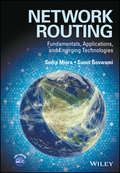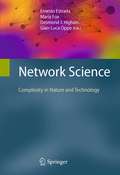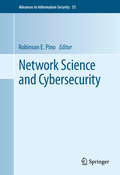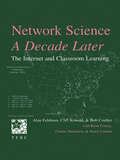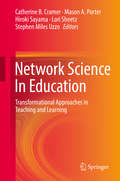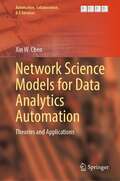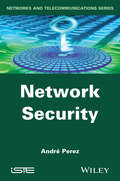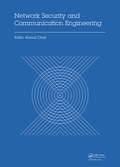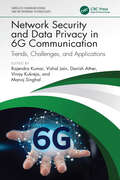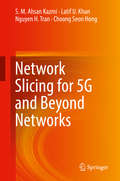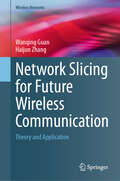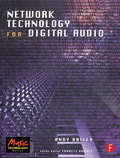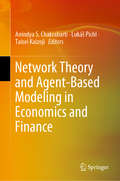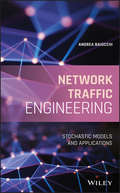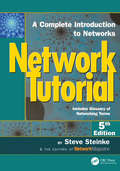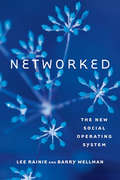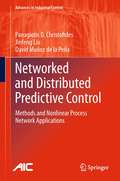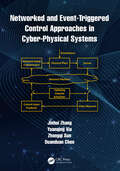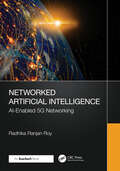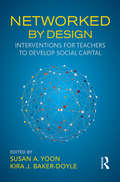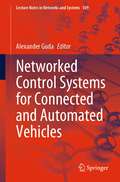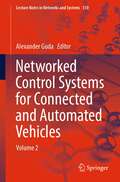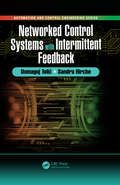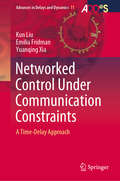- Table View
- List View
Network Routing: Fundamentals, Applications, and Emerging Technologies
by Sudip Misra Sumit GoswamiNetwork Routing: Fundamentals, Applications and Emerging Technologies serves as single point of reference for both advanced undergraduate and graduate students studying network routing, covering both the fundamental and more moderately advanced concepts of routing in traditional data networks such as the Internet, and emerging routing concepts currently being researched and developed, such as cellular networks, wireless ad hoc networks, sensor networks, and low power networks.
Network Science
by Desmond J. Higham Gian-Luca Oppo Ernesto Estrada Maria FoxNetwork Science is the emerging field concerned with the study of large, realistic networks. This interdisciplinary endeavor, focusing on the patterns of interactions that arise between individual components of natural and engineered systems, has been applied to data sets from activities as diverse as high-throughput biological experiments, online trading information, smart-meter utility supplies, and pervasive telecommunications and surveillance technologies. This unique text/reference provides a fascinating insight into the state of the art in network science, highlighting the commonality across very different areas of application and the ways in which each area can be advanced by injecting ideas and techniques from another. The book includes contributions from an international selection of experts, providing viewpoints from a broad range of disciplines. It emphasizes networks that arise in nature--such as food webs, protein interactions, gene expression, and neural connections--and in technology--such as finance, airline transport, urban development and global trade. Topics and Features: begins with a clear overview chapter to introduce this interdisciplinary field; discusses the classic network science of fixed connectivity structures, including empirical studies, mathematical models and computational algorithms; examines time-dependent processes that take place over networks, covering topics such as synchronisation, and message passing algorithms; investigates time-evolving networks, such as the World Wide Web and shifts in topological properties (connectivity, spectrum, percolation); explores applications of complex networks in the physical and engineering sciences, looking ahead to new developments in the field. Researchers and professionals from disciplines as varied as computer science, mathematics, engineering, physics, chemistry, biology, ecology, neuroscience, epidemiology, and the social sciences will all benefit from this topical and broad overview of current activities and grand challenges in the unfolding field of network science.
Network Science and Cybersecurity
by Robinson E. PinoNetwork Science and Cybersecurity introduces new research and development efforts for cybersecurity solutions and applications taking place within various U.S. Government Departments of Defense, industry and academic laboratories. This book examines new algorithms and tools, technology platforms and reconfigurable technologies for cybersecurity systems. Anomaly-based intrusion detection systems (IDS) are explored as a key component of any general network intrusion detection service, complementing signature-based IDS components by attempting to identify novel attacks. These attacks may not yet be known or have well-developed signatures. Methods are also suggested to simplify the construction of metrics in such a manner that they retain their ability to effectively cluster data, while simultaneously easing human interpretation of outliers. This is a professional book for practitioners or government employees working in cybersecurity, and can also be used as a reference. Advanced-level students in computer science or electrical engineering studying security will also find this book useful .
Network Science, A Decade Later: The Internet and Classroom Learning
by Alan Feldman Cliff Konold Bob Coulter Brian ConroyNetwork Science, A Decade Later--the result of NSF-funded research that looked at the experiences of a set of science projects which use the Internet--offers an understanding of how the Internet can be used effectively by science teachers and students to support inquiry-based teaching and learning. The book emphasizes theoretical and critical perspectives and is intended to raise questions about the goals of education and the ways that technology helps reach those goals and ways that it cannot. The theoretical perspective of inquiry-based teaching and learning in which the book is grounded is consistent with the current discipline-based curriculum standards and frameworks. The chapters in Part I, "State of the Art," describe the history and current practice of network science. Those in Part II, "Looking Deeply," extend the inquiry into network science by examining discourse and data in depth, using both empirical data and theoretical perspectives. In Part III, "Looking Forward," the authors step back from the issues of network science to take a broader view, focusing on the question: How should the Internet be used--and not used--to support student learning? The book concludes with a reminder that technology will not replace teachers. Rather, the power of new technologies to give students both an overwhelming access to resources--experts, peers, teachers, texts, images, and data--and the opportunity to pursue questions of their own design, increases the need for highly skilled teachers and forward-looking administrators. This is a book for them, and for all educators, policymakers, students involved in science and technology education. For more information about the authors, an archived discussions space, a few chapters that can be downloaded as PDF files, and ordering information, visit teaparty.terc.edu/book/
Network Science In Education: Transformational Approaches in Teaching and Learning
by Catherine B. Cramer Mason A. Porter Hiroki Sayama Lori Sheetz Stephen Miles UzzoAround the globe, there is an increasingly urgent need to provide opportunities for learners to embrace complexity; to develop the many skills and habits of mind that are relevant to today's complex and interconnected world; and to make learning more connected to our rapidly changing workplace and society. This presents an opportunity to (1) leverage new paradigms for understanding the structure and function of teaching and learning communities, and (2) to promote new approaches to developing methods, curricular materials, and resources. Network science - the study of connectivity - can play an important role in these activities, both as an important subject in teaching and learning and as a way to develop interconnected curricula. Since 2010, an international community of network science researchers and educators has come together to raise the global level of network literacy by applying ideas from network science to teaching and learning. Network Science in Education - which refers to both this community and to its activities - has evolved in response to the escalating activity in the field of network science and the need for people to be able to access the field through education channels. Network Science In Education: Transformational Approaches in Teaching and Learning appeals to both instructors and professionals, while offering case studies from a wide variety of activities that have been developed around the globe: the creation of entirely new courses and degree programs; tools for K-20 learners, teachers, and the general public; and in-depth analysis of selected programs. As network-based pedagogy and the community of practice continues to grow, we hope that the book's readers will join this vibrant network education community to build on these nascent ideas and help deepen the understanding of networks for all learners.
Network Science Models for Data Analytics Automation: Theories and Applications (Automation, Collaboration, & E-Services #9)
by Xin W. ChenThis book explains network science and its applications in data analytics for critical infrastructures, engineered systems, and knowledge acquisition. Each chapter describes step-by-step processes of how network science enables and automates data analytics through examples. The book not only dissects modeling techniques and analytical results but also explores the intrinsic development of these models and analyses. This unique approach bridges the gap between theory and practice and channels’ managerial and problem-solving skills. Engineers, researchers, and managers would benefit from the extensive theoretical background and practical examples discussed in this book. Advanced undergraduate students and graduate students in mathematics, statistics, engineering, business, public health, and social science may use this book as a one-semester textbook or a reference book. Readers who are more interested in applications may skip Chapter 1 and peruse through the rest of the book with ease.
Network Security
by André PerezThis book introduces the security mechanisms deployed in Ethernet, Wireless-Fidelity (Wi-Fi), Internet Protocol (IP) and MultiProtocol Label Switching (MPLS) networks. These mechanisms are grouped throughout the book according to the following four functions: data protection, access control, network isolation, and data monitoring.Data protection is supplied by data confidentiality and integrity control services. Access control is provided by a third-party authentication service. Network isolation is supplied by the Virtual Private Network (VPN) service. Data monitoring consists of applying rules to data in order to authorize its transfer or detect attacks.The chapters of the book cover cryptography, 802.1x mechanism, WPA mechanisms, IPSec mechanism, SSL/TLS/DTLS protocols, network management, MPLS technology, Ethernet VPN, firewalls and intrusion detection.
Network Security and Communication Engineering: Proceedings of the 2014 International Conference on Network Security and Communication Engineering (NSCE 2014), Hong Kong, December 25-26, 2014
by Kennis ChanThe conference on network security and communication engineering is meant to serve as a forum for exchanging new developments and research progresss between scholars, scientists and engineers all over the world and providing a unique opportunity to exchange information, to present the latest results as well as to review the relevant issues on
Network Security and Data Privacy in 6G Communication: Trends, Challenges, and Applications (Wireless Communications and Networking Technologies)
by Rajendra Kumar Vishal Jain Danish Ather Vinay KukrejaThis book proposes robust solutions for securing a network against intrusions for data privacy and safety. It includes theoretical models, commercialization of validated models, and case studies. Explains the integration of technologies such as artificial intelligence, the Internet of Things, and blockchain for network security in a 6G communication system. Highlights the challenges such as spectrum allocation and management, network architecture and heterogeneity, energy efficiency and sustainability, antenna, and radio frequency. Discuss theories like quantum-safe cryptography, zero-trust networking, and blockchain-based trust management. Covers emerging technologies including homomorphic encryption, secure multi-party computation, post-quantum cryptography, and distributed ledger technology for security and privacy in 6G communication systems. Presents light and deep secure algorithms to detect fake incidents in wireless communication. The text is primarily written for senior undergraduates, graduate students, and academic researchers in fields including electrical engineering, electronics and communications engineering, and computer science.
Network Slicing for 5G and Beyond Networks
by S. M. Kazmi Latif U. Khan Nguyen H. Tran Choong Seon HongThis book provides a comprehensive guide to the emerging field of network slicing and its importance to bringing novel 5G applications into fruition. The authors discuss the current trends, novel enabling technologies, and current challenges imposed on the cellular networks. Resource management aspects of network slicing are also discussed by summarizing and comparing traditional game theoretic and optimization based solutions. Finally, the book presents some use cases of network slicing and applications for vertical industries. Topics include 5G deliverables, Radio Access Network (RAN) resources, and Core Network (CN) resources. Discusses the 5G network requirements and the challenges therein and how network slicing offers a solutionFeatures the enabling technologies of future networks and how network slicing will play a rolePresents the role of machine learning and data analytics for future cellular networks along with summarizing the machine learning approaches for 5G and beyond networks
Network Slicing for Future Wireless Communication: Theory and Application (Wireless Networks)
by Haijun Zhang Wanqing GuanThis book comprehensively discusses the development, application and challenges of network slicing technology in wireless communications. Starting with the basic concept and enabling technologies of network slicing, this book introduces how to integrate AI (Artificial Intelligence) technology into the end-to-end deployment, resource allocation and performance enhancement for multi-tenant slicing. An in-depth exploration of managing multi-domain slices deployed in the federated infrastructure networks is presented, including on-demand cooperation among multiple infrastructure networks, distinct slice deployment, hierarchical slice orchestration and fast slice adaption. As a guide to leveraging AI to enhance traffic performance of multi-tenant slicing and customize resource slicing for industrial scenarios, this book provides insights, modeling, applications and research issues. A holistic perspective on prominent role of network slicing in managing wireless network resources is provided as well. Overall, network slicing as a key technology of wireless networks, enables to satisfy differentiated service demands of multiple tenants from vertical industries with the same shared physical infrastructure network. As future wireless networks are expected to facilitate the evolution of vertical industries, various vertical enterprises as tenants require an intelligent network slicing paradigm to provide highly customizable services. AI-based management system for network slicing excel at deploying slices rapidly, allocating resources efficiently and avoiding service quality degradation. With the increasing diversity of service demands and complexity of communication environment, incorporating AI into network slicing is a necessity for improving flexibility and automation of resource management. This book targets advanced-level students in information and communication sciences as a secondary textbook. Researchers and industry professionals working in various areas, such as wireless communication systems, network management and orchestration, resource allocation and AI-enabled wireless networks will also find this book useful as reference book.
Network Technology for Digital Audio
by Andy BaileyNetwork Technology for Digital Audio examines the transfer of audio and other related data over digital communication networks. Encompassing both the data communication and audio industries,it unravels the intricacies of computer networking technique and theory, viewed from an audio perspective. Looking at commercial and ratified standards both current and developing, this book covers digital architectural solutions such as IEEE 1394 (Firewire), USB, Fibre Channel and ATM alongside their counterparts within the audio industry:*S/P DIF, ADAT, AES/EBU and MADI are discussed from the audio industry standpoint and solutions contrasted*Explanations of packet switching and internetworking are also included.Studying new developments and trends, it covers the pros and cons and looks at the work being done to deliver the requirements of the digital audio environment. Proprietary and open systems developed within the audio industry are examined, with each case being supported with appropriate history and clear technical explanation.The book helps readers build a better understanding of the issues surrounding the transfer of real-time audio digital data. Touching on the history of the Internet, and the technologies it spawned, it explains the theory and possibilities for the same technologies to support inter-device communications within a studio environment. Network Technology For Digital Audio will provide on tap knowledge for students and lecturers on audio-related and music technology courses and will prepare the working professionals within the industry for progress and changes to come. Network Technology for Digital Audio is part of the Focal Press Music Technology Series.
Network Theory and Agent-Based Modeling in Economics and Finance
by Anindya S. Chakrabarti Lukáš Pichl Taisei KaizojiThis book presents the latest findings on network theory and agent-based modeling of economic and financial phenomena. In this context, the economy is depicted as a complex system consisting of heterogeneous agents that interact through evolving networks; the aggregate behavior of the economy arises out of billions of small-scale interactions that take place via countless economic agents. The book focuses on analytical modeling, and on the econometric and statistical analysis of the properties emerging from microscopic interactions. In particular, it highlights the latest empirical and theoretical advances, helping readers understand economic and financial networks, as well as new work on modeling behavior using rich, agent-based frameworks. Innovatively, the book combines observational and theoretical insights in the form of networks and agent-based models, both of which have proved to be extremely valuable in understanding non-linear and evolving complex systems. Given its scope, the book will capture the interest of graduate students and researchers from various disciplines (e.g. economics, computer science, physics, and applied mathematics) whose work involves the domain of complexity theory.
Network Tomography: Identifiability, Measurement Design, and Network State Inference
by Ting He Liang Ma Ananthram Swami Don TowsleyProviding the first truly comprehensive overview of Network Tomography - a novel network monitoring approach that makes use of inference techniques to reconstruct the internal network state from external vantage points - this rigorous yet accessible treatment of the fundamental theory and algorithms of network tomography covers the most prominent results demonstrated on real-world data, including identifiability conditions, measurement design algorithms, and network state inference algorithms, alongside practical tools for applying these techniques to real-world network management. It describes the main types of mathematical problems, along with their solutions and properties, and emphasizes the actions that can be taken to improve the accuracy of network tomography. With proofs and derivations introduced in an accessible language for easy understanding, this is an essential resource for professional engineers, academic researchers, and graduate students in network management and network science.
Network Traffic Engineering: Stochastic Models and Applications
by Andrea BaiocchiA comprehensive guide to the concepts and applications of queuing theory and traffic theory Network Traffic Engineering: Models and Applications provides an advanced level queuing theory guide for students with a strong mathematical background who are interested in analytic modeling and performance assessment of communication networks. The text begins with the basics of queueing theory before moving on to more advanced levels. The topics covered in the book are derived from the most cutting-edge research, project development, teaching activity, and discussions on the subject. They include applications of queuing and traffic theory in: LTE networks Wi-Fi networks Ad-hoc networks Automated vehicles Congestion control on the Internet The distinguished author seeks to show how insight into practical and real-world problems can be gained by means of quantitative modeling. Perfect for graduate students of computer engineering, computer science, telecommunication engineering, and electrical engineering, Network Traffic Engineering offers a supremely practical approach to a rapidly developing field of study and industry.
Network Tutorial: A Complete Introduction to Networks Includes Glossary of Networking Terms
by Steve SteinkeNetwork Tutorial delivers insight and understanding about network technology to managers and executives trying to get up to speed or stay current with the complex challenges of designing, constructing, maintaining, upgrading, and managing the netwo
Networked: The New Social Operating System (Contemporary Studies In Sociology Ser. #Vol. 15)
by Lee Rainie Barry WellmanHow social networks, the personalized Internet, and always-on mobile connectivity are transforming—and expanding—social life.Daily life is connected life, its rhythms driven by endless email pings and responses, the chimes and beeps of continually arriving text messages, tweets and retweets, Facebook updates, pictures and videos to post and discuss. Our perpetual connectedness gives us endless opportunities to be part of the give-and-take of networking.Some worry that this new environment makes us isolated and lonely. But in Networked, Lee Rainie and Barry Wellman show how the large, loosely knit social circles of networked individuals expand opportunities for learning, problem solving, decision making, and personal interaction. The new social operating system of “networked individualism” liberates us from the restrictions of tightly knit groups; it also requires us to develop networking skills and strategies, work on maintaining ties, and balance multiple overlapping networks.Rainie and Wellman outline the “triple revolution” that has brought on this transformation: the rise of social networking, the capacity of the Internet to empower individuals, and the always-on connectivity of mobile devices. Drawing on extensive evidence, they examine how the move to networked individualism has expanded personal relationships beyond households and neighborhoods; transformed work into less hierarchical, more team-driven enterprises; encouraged individuals to create and share content; and changed the way people obtain information. Rainie and Wellman guide us through the challenges and opportunities of living in the evolving world of networked individuals.
Networked and Distributed Predictive Control
by David Muñoz de la Peña Jinfeng Liu Panagiotis D. ChristofidesNetworked and Distributed Predictive Control presents rigorous, yet practical, methods for the design of networked and distributed predictive control systems - the first book to do so. The design of model predictive control systems using Lyapunov-based techniques accounting for the influence of asynchronous and delayed measurements is followed by a treatment of networked control architecture development. This shows how networked control can augment dedicated control systems in a natural way and takes advantage of additional, potentially asynchronous and delayed measurements to maintain closed loop stability and significantly to improve closed-loop performance. The text then shifts focus to the design of distributed predictive control systems that cooperate efficiently in computing optimal manipulated input trajectories that achieve desired stability, performance and robustness specifications but spend a fraction of the time required by centralized control systems. Key features of this book include: * new techniques for networked and distributed control system design; * insight into issues associated with networked and distributed predictive control and their solution; * detailed appraisal of industrial relevance using computer simulation of nonlinear chemical process networks and wind- and solar-energy-generation systems; and * integrated exposition of novel research topics and rich resource of references to significant recent work. A full understanding of Networked and Distributed Predictive Control requires a basic knowledge of differential equations, linear and nonlinear control theory and optimization methods and the book is intended for academic researchers and graduate students studying control and for process control engineers. The constant attention to practical matters associated with implementation of the theory discussed will help each of these groups understand the application of the book's methods in greater depth.
Networked and Event-Triggered Control Approaches in Cyber-Physical Systems
by Jinhui Zhang Yuanqing Xia Zhongqi Sun Duanduan ChenThe insertion of communication networks in feedback control loops complicates analysis and synthesis of cyber-physical systems (CPSs), and network-induced uncertainties may degrade system control performance. Thus, this book researches networked delay compensation and event-triggered control approaches for a series of CPSs subject to network-induced uncertainties. The authors begin with an introduction to the concepts and challenges of CPSs, followed by an overview of networked control approaches and event-triggered control strategies in CPSs. Then, networked delay compensation and event-triggered control approaches are proposed for CPSs with network communication delay, data dropout, signal quantization, and event-triggered communication. More specifically, networked delay compensation approaches are proposed for linear/nonlinear networked controlled plants with time-varying and random network communication delays and data dropouts. To reduce computational burden and network communication loads in CPSs, event-triggered control, self-triggered control, co-design of event-triggered control and quantized control techniques, and event-triggered disturbance rejection control approaches are also presented. This book is an essential text for researchers and engineers interested in cybersecurity, networked control, and CPSs. It would also prove useful for graduate students in the fields of science, engineering, and computer science.
Networked Artificial Intelligence: AI-Enabled 5G Networking
by Radhika Ranjan RoyThe integration of fifth generation (5G) wireless technologies with distributed artificial intelligence (AI) is transforming network operations. AI is increasingly embedded in all network elements, from cloud and edge to terminal devices, enabling AI to function as a networking system. This convergence facilitates AI-based applications across the global network, with notable successes in various domains such as computer vision, natural language processing, and healthcare. Networked Artificial Intelligence: AI-Enabled 5G Networking a comprehensive framework for the deep integration of computing and communications, optimizing networks and applications as a unified system using AI.The book covers topics ranging from networked AI fundamentals to AI-enabled 5G networks, including agent modeling, machine learning (ML) algorithms, and network protocol architectures. It discusses how network service providers can leverage AI and ML techniques to customize network baselines, reduce noise, and accurately identify issues. It also looks at AI-driven networks that enable self-correction for maximum uptime and prescriptive actions for issue resolution, as well as troubleshooting by capturing and storing data before network events.The book presents a comprehensive approach to AI-enabled networking that offers unprecedented opportunities for efficiency, reliability, and innovation in telecommunications. It works through the approach’s five steps of connection, communication, collaboration, curation, and community. These steps enhance network effects, empowering operators with insights for trusted automation, cost reduction, and optimal user experiences. The book also discusses AI and ML capabilities that enable networks to continuously learn, self-optimize, and predict and rectify service degradations proactively, even with full automation.
Networked By Design: Interventions for Teachers to Develop Social Capital
by Susan A. Yoon Kira J. Baker-DoyleNetworked by Design brings together work from leading international scholars in the learning sciences that applies social network theory to teachers’ social interactions and relationships. The volume examines the direct and indirect relationships and communities that teachers navigate, as well as the models, plans, and other interventions that allow them to exercise control over these networks. Each chapter draws from case studies or latitudinal research to investigate a different intervention and its outcomes. By presenting research conducted in a variety of scales and contexts, this book offers scholars, future teachers, and leaders diverse insights into how interventions in social capital and social networks can create impactful, meaningful teaching and learning.
Networked Control Systems for Connected and Automated Vehicles: Volume 1 (Lecture Notes in Networks and Systems #509)
by Alexander GudaThis book is a collection of the latest research findings in such areas as networked multi-agent systems, co-design of communication and control, distributed control strategies that can cope with asynchrony between local loops, event-triggered control, modelling of network infrastructure, novel concepts of distributed control for networked and cyber-physical systems. The book contains the result of the latest research in the field of communication and control system design to support networked control systems with stringent real-time requirements. It introduces readers to research in the field of joint design of the control and communication protocol and presents the latest developments in the area of novel optimal control and scheduling designs under resource constraints.The book also covers the issues of creating emerging information and communication technologies for traffic estimation and control, connected and autonomous technology applications and modelling for commercial and shared vehicle operations. The reader will find information on emerging cyber-physical systems, networked multi-agent systems, large-scale distributed energy systems, as well as on real-time systems, safety and security systems.A significant block of studies is devoted to the topic of transitions towards electrification and automation of vehicles. Modern concepts of road infrastructure construction are described in detail in the presented research papers.Automotive industry professionals will be particularly interested in the sections on the novel mechanisms for medium access in multi-hop wireless networks with real-time requirements, optimal layering architecture and co-design for wireless communication. The book will be incredibly interesting for researchers interested in human–digital interfaces, industrial Internet of Things, artificial intelligence and machine learning.
Networked Control Systems for Connected and Automated Vehicles: Volume 2 (Lecture Notes in Networks and Systems #510)
by Alexander GudaControl of large-scale distributed energy systems over communication networks is an important topic with many application domains. The book presents novel concepts of distributed control for networked and cyber-physical systems (CPS), such as smart industrial production lines, smart energy grids, and autonomous vehicular systems. It focuses on new solutions in managing data and connectivity to support connected and automated vehicles (CAV).The book compiles original research papers presented at the conference “Networked Control Systems for Connected and Automated Vehicles” (Russia). The latest connected and automated vehicle technologies for next generation autonomous vehicles are presented. The book sets new goals for the standardization of the scientific results obtained and the advancement to the level of full autonomy and full self-driving (FSD). The book presents the latest research in artificial intelligence, assessing virtual environments, deep learning systems, and sensor fusion for automated vehicles. Particular attention is paid to new safety standards, safety and security systems, and control of epidemic spreading over networks. The issues of building modern transport infrastructure facilities are also discussed in the articles presented in this book.The book is of considerable interest to scientists, researchers, and graduate students in the field of transport systems, as well as for managers and employees of companies using or producing equipment for these systems.
Networked Control Systems with Intermittent Feedback (Automation and Control Engineering)
by Domagoj Tolić Sandra HircheNetworked Control Systems (NCSs) are spatially distributed systems for which the communication between sensors, actuators and controllers is realized by a shared (wired or wireless) communication network. NCSs offer several advantages, such as reduced installation and maintenance costs, as well as greater flexibility, over conventional control systems in which parts of control loops exchange information via dedicated point-to-point connections. The principal goal of this book is to present a coherent and versatile framework applicable to various settings investigated by the authors over the last several years. This framework is applicable to nonlinear time-varying dynamic plants and controllers with delayed dynamics; a large class of static, dynamic, probabilistic and priority-oriented scheduling protocols; delayed, noisy, lossy and intermittent information exchange; decentralized control problems of heterogeneous agents with time-varying directed (not necessarily balanced) communication topologies; state- and output-feedback; off-line and on-line intermittent feedback; optimal intermittent feedback through Approximate Dynamic Programming (ADP) and Reinforcement Learning (RL); and control systems with exogenous disturbances and modeling uncertainties.
Networked Control Under Communication Constraints: A Time-Delay Approach (Advances in Delays and Dynamics #11)
by Kun Liu Emilia Fridman Yuanqing XiaThis book presents a time-delay approach to the analysis and synthesis of networked control systems (NCSs) under communication constraints. Differently from other approaches, the time-delay approach to NCSs allows communication delays to be larger than the sampling intervals in the presence of scheduling protocols. The book starts from a comprehensive introduction to three main approaches to sampled-data and networked control. It then focuses on time-delay approach, and the modelling of the closed-loop systems in the form of time-delay system. It presents discontinuous (in time) Lyapunov functional constructions that are efficient for NCSs in the presence of communications delays. Further, it highlights time-delay approaches developed to model and analyze NCSs under communication constraints, with a particular focus on dynamic quantization, round-robin, try-once-discard and stochastic protocols. The results are first presented for the continuous-time NCSs and then extended to discrete-time NCSs. Discussing recent developments in Lyapunov-based analysis of NCSs under communication constraints, the book is a valuable resource for researchers interested in sampled-data and networked control, and time-delay systems, as well as for graduate students in automatic control and systems theory.
